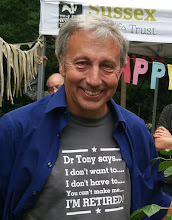I had the privilege of attending a packed meeting last Friday, organised by LAMBS, in opposition to the new town that a developer is proposing in the countryside outside Henfield. Around 500 people crammed into a large hall in Burgess Hill to express their concerns.
The panel
of speakers included Arundel and Downs MP, Nick
Herbert ; Mid Sussex MP, Nicholas Soames; Mid Sussex District
Councillor, Norman Webster; Hosham District Councillor, Brian O’Connell;
Founder of LAMBS, Anthony Watts WilliamsDr Roger Smith, Sussex CPRE, Kenneth
MacIntosh from Hands Off Henfield and I was there too.
It was an
excellent meeting, giving a very clear message to these predatory developers
and I recommend that you read Jane Simmons piece about the meeting on the LAMBS
website.
There
was, however, one thing we did not have time to delve into. We did not really question the propaganda
that is constantly promoted by developers.
We all
know the story. We need houses, the
environment is a block on development, and all these protesters are just being
NIMBYs by preventing people getting homes!
The constant line we are fed is that there is a lack of capacity – not
enough homes, we must build more and governments are judged on how many houses
they build.
But
simple answers to complex problems are always wrong.
Let’s
have a look at a few statistics.
If this
lack of capacity was true then we would expect to be seeing increasing numbers
of people being crammed into ever smaller houses. The truth, however, is the opposite.
About 10
years ago there was an average of 2.4 people per house. Today there is an average of 2.3. The drive for more house building is largely
a result of fewer people living in each house.
Broadly, what seems to be happening is we are spreading the same number
of people into a larger number of houses.
To take
this to a ridiculous extreme you can project this continuous decline of the
number of people per house into the future.
If you do this you get to a point in 230 years time where there is
nobody living in any houses no matter how many you build!
A mindset
based on predict and provide has obvious shortcomings.
We seem
to accept, unquestioningly, that we need more houses so that young families, in
particular, will have somewhere to live in the future. Yet building more houses alone does not solve
the problem. We just end up with fewer
people per house and those young families can still not find a home.
There are
far more complex issues at work here requiring social, economic and political
answers – why are people needing homes not able to get them whilst others are
able to spread into more houses? Gritty
problems way outside the remit of a Wildlife Trust, but problems our
politicians should be addressing. We are
being deflected in a “homes versus the environment” argument as an alternative
to finding more complex solutions. This
deflection benefits no one except the development industry.
We have
become obsessed with housing numbers because of the “frame” of the argument,
set by developers to their own advantage.
If we spend all our time arguing about who can build most houses and
where we are going to put them, then developers do very nicely out of it!
In
practice, as ever, the environment is used as a scape-goat. Instead of addressing socio-economic problems
driving a lack of homes we vaguely hope that destroying a bit more environment
in order to build a new town will somehow be the solution. It won’t be but in the mean time the
developer will have moved on to his next lucrative project.
